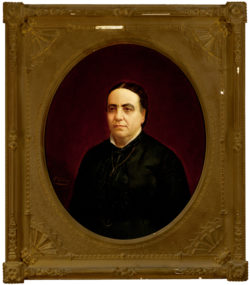John Genin
John Genin as primarily known as a portrait painter, but he also produced historical, genre, and landscape painting in nineteenth century New Orleans.

Courtesy of The Historic New Orleans Collection
Mrs. Charles Theodore Soniat du Fossat, nee Marie Amenaide LaBranche. Genin, John (Artist)
Born in Lyons, France, in 1830, painter John Genin never severed his ties to his native country either personally or professionally. He was a resident of New Orleans for most of his lifetime, but he often made return visits to France, and his work continued to show the influence of French academic painting. Although he produced historical, genre, and landscape paintings, he was chiefly known for his portraiture, and he was the painter of choice for many prominent families in New Orleans, especially for depictions of their women, children, and the elderly. His likenesses have been influenced by photography. Genin’s body of work, or at least the number of paintings that can be attributed to him today, is relatively small.
Before migrating to the United States, Genin studied with Léon Bonnat in Paris. His first appearance in New Orleans was probably noted in the census of 1860 in which “Johanny Genin,” age 30 and born in France, was listed. In 1865, he reappears in public notice when one of his historical paintings garnered critical acclaim, and in 1866 some of his sketches were published in Almanach de la Louisiane.
The influence of the French academic approach is particularly apparent in Genin’s allegorical paintings. At least three such works (produced in 1870, 1879–80, and 1884) are devoted to the theme of Louisiana. In Spirit of Louisiana, for example, he used his second wife as a model for a painting depicting a Greek goddess in a classical costume. Spanish moss encircles her waist and hangs over her head.
During his summer trips to France, Genin maintained his professional contacts. In 1878, while visiting the Universal Exposition in Paris, for example, he exhibited his paintings at the Champ de Mars and at private shows. He also visited the studios of some of Paris’s leading painters. After1879 he exhibited primarily at the store of Laurent Uter in New Orleans, and by 1886 he kept a studio there. By the time of his death on October 19, 1895, he was considered to be one of the leading painters in the city.
